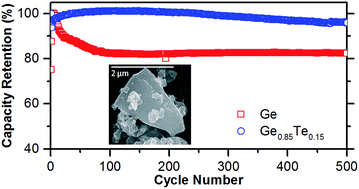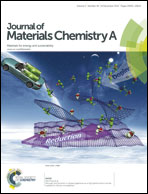Obviating the need for nanocrystallites in the extended lithiation/de-lithiation of germanium†
Abstract
Mainstream rechargeable lithium battery materials research of the past 20 years has focused on nano-particulate materials, where Li+-diffusion lengths exceeded at designated cycling rates the particle radii, and where the particles slipped rather than broke upon their expansion and shrinkage in lithiation/delithiation cycles. Here we show that in intrinsically rapidly Li+-transporting macrocrystalline germanium and even more so in a dispersion of non-cycling Li2Te in macrocrystalline germanium it is unnecessary to use nanocrystalline materials and that Li2Te increases the retained capacity at 1C rate after 500 cycles. A dispersion of 17.65 atom% of crystalline GeTe in 82.35 atom% crystalline Ge was synthesized by quenching from the melt followed by high energy ball milling to 1 μm–5 μm particle size. The particles, as well as similarly made and similarly sized pure Ge particles were incorporated in electrodes, which were galvanostatically lithiated/delithiated. In the initial cycle, GeTe is reduced to LixGe alloys and Li2Te. In 500 1C cycles of LixGe delithiation/Ge lithiation the capacity of the pure Ge faded more rapidly than that of the Ge electrodes containing Li2Te, which retained 96% of their initial capacity after 500 cycles at 1C rate.


 Please wait while we load your content...
Please wait while we load your content...